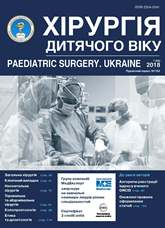Influence of the eviscerated bowel status on digestive tract motility recovery after surgery for gastrochisis in neonates
DOI:
https://doi.org/10.15574/PS.2018.58.75Keywords:
gastroschisis, eviscerated organs status, motility restoration, newborns.Level of evidence, Level III, retrospective comparative studyAbstract
Background. According to current literature, intestinal damage in gastroschisis (GS) leads to an increase in morbidity and mortality. However, the correlation between impairment degree of the eviscerated bowel and the restoration of gastrointestinal motility (GIM) after the operation remains unresolved issue.Objective: to determine the impact of the impairment degree of eviscerated intestine on the restoration of GIM after surgery for GS.
Material and methods. The analysis of treatment results of 51 patients with simple GS who recovered after the surgical treatment was performed. All patients were divided into three groups. Group 1 included patients with intact bowel (n=12, 23.5%). Newborns with moderate intestinal damage were included to the 2nd group (n=23, 45.1%). In the 3rd group, severe bowel damage was diagnosed (n=16; 31.4%).
Results. In patients who were enrolled to the study the terms of active peristalsis and stools appearance, gastrostasis duration, time of complete enteral nutrition achievement in the postoperative period were studied. After assessing the statistical significance of the difference between 1 and 2 groups, there were no significant differences in the studied statements (P≥0.05; p=0.05–0.27). The assessment of the statistical significance of the difference between the first two groups and the third group showed a significant difference in terms of active peristalsis appearance (р˂0.01), gastrostasis discontinuation (p=0.01), bowel movements uprise (p=0.01) and the time of introduction (p=0.01) and achievement of complete enteral nutrition (p=0.02).
Conclusions. Mild and moderate intestinal damage had minor effect on the restoration of GIM. The severe damage of the eviscerated bowel loops has significant effect on the GIM restoration in the postoperative period.
References
Auber F, Danzer E, Noche-Monnery ME et al. (2013). Enteric nervous system impairment in gastroschisis. Eur J Pediatr Surg. 23(1): 29–38. PMid:23100056
Bittencourt DG, Barreto MW, Franca WM et al. (2006). Impact of corticosteroid on intestinal injury in a gastroschisis rat model: morphometric analysis. J Pediatr Surg. 41(3): 547–553. https://doi.org/10.1016/j.jpedsurg.2005.11.050; PMid:16516633
Carnaghan H, Pereira S, James CP, Charlesworth PB et al. (2014). Is early delivery beneficial in gastroschisis? J Pediatr Surg. 49(6): 928–933. https://doi.org/10.1016/j.jpedsurg.2014.01.027; PMid:24888837
Feng C, Graham CD, Connors JP et al. (2016). Transamniotic stem cell therapy (TRASCET) mitigates bowel damage in a model of gastroschisis. J Pediatr Surg. 51(1). 56–61. https://doi.org/10.1016/j.jpedsurg.2015.10.011
Gelas T, Gorduza D, Devonec S et al. (2008). Scheduled preterm delivery for gastroschisis improves postoperative outcome. Pediatr. Surg. Int. 24(9): 1023–1029. https://doi.org/10.1007/s00383-008-2204-y; PMid:18668252
Hakguder G, Ateş O, Olguner M et al. (2002). Induction of fetal diuresis with intraamniotic furosemide increases the clearance of intraamniotic substances: An alternative therapy aimed at reducing intraamniotic meconium concentration. J Pediatr Surg. 37(9): 1337–1342. https://doi.org/10.1053/jpsu.2002.35004; PMid:12194128
Jorge Correia-Pinto, Marta L Tavares, Maria J Baptista et al. (2002). Meconium dependence of bowel damage in gastroschisis. J Pediatr Surg. 41 (5): 897–900.
Maramreddy H, Fisher J, Slim M et al. (2009). Delivery of gastroschisis patients before 37 weeks of gestation is associated with increased morbidities. J Pediatr Surg. 44(7): 1360–1366. https://doi.org/10.1016/j.jpedsurg.2009.02.006; PMid:19573662
Midrio P, Faussone-Pellegrini MS, Vannucchi MG et al. (2004). Gastroschisis in the rat model is associated with a delayed maturation of intestinal pacemaker cells and smooth muscle cells. J Pediatr Surg. 39(10): 1541–1547. https://doi.org/10.1016/j.jpedsurg.2004.06.017; PMid:15486901
Nasr A, Wayne C, Bass J et al. (2013). Effect of delivery approach on outcomes in fetuses with gastroschisis. J Pediatr Surg. 48(11): 2251–2255. https://doi.org/10.1016/j.jpedsurg.2013.07.004; PMid:24210195
Piper HG, Jaksic T. (2006). The impact of prenatal bowel dilation on clinical outcomes in neonates with gastroschisis. J Pediatr Surg. 41(5): 897–900. https://doi.org/10.1016/j.jpedsurg.2006.01.005; PMid:16677878
Santos MM, Tannuri U, Maksoud JG. (2003). Alterations of enteric nerve plexus in experimental gastroschisis: is there a delay in the maturation? J Pediatr Surg. 38(10): 1506–1511. https://doi.org/10.1016/S0022-3468(03)00504-9
Vargun R, Aktug T, Heper A et al. (2007). Effects of intrauterine treatment on interstitial cells of Cajal in gastroschisis. J Pediatr Surg. 42(5): 783–787. https://doi.org/10.1016/j.jpedsurg.2006.12.062; PMid:17502183
Youssef F, Laberge JM, Baird RJ. (2015). The correlation between the time spent in utero and the severity of bowel matting in newborns with gastroschisis. J Pediatr Surg. 50(5): 755–759. https://doi.org/10.1016/j.jpedsurg.2015.02.030; PMid:25783374
Downloads
Issue
Section
License
The policy of the Journal “PAEDIATRIC SURGERY. UKRAINE” is compatible with the vast majority of funders' of open access and self-archiving policies. The journal provides immediate open access route being convinced that everyone – not only scientists - can benefit from research results, and publishes articles exclusively under open access distribution, with a Creative Commons Attribution-Noncommercial 4.0 international license(СС BY-NC).
Authors transfer the copyright to the Journal “PAEDIATRIC SURGERY.UKRAINE” when the manuscript is accepted for publication. Authors declare that this manuscript has not been published nor is under simultaneous consideration for publication elsewhere. After publication, the articles become freely available on-line to the public.
Readers have the right to use, distribute, and reproduce articles in any medium, provided the articles and the journal are properly cited.
The use of published materials for commercial purposes is strongly prohibited.

